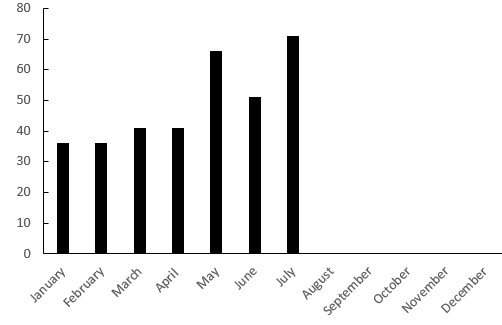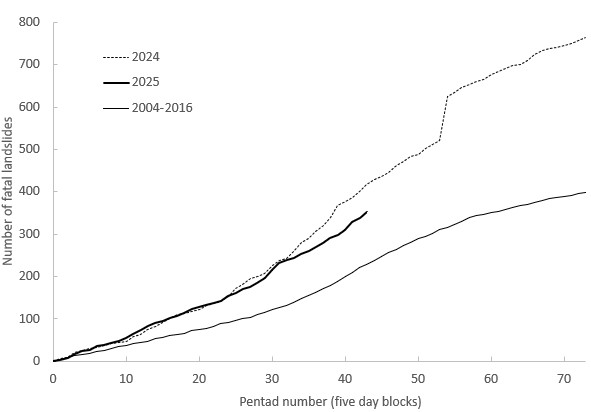In July 2025, I recorded 71 fatal landslides worldwide, with the loss of 214 lives.
Each year, July is one of the key months for the occurrence of fatal landslides globally as the Asian monsoon season cranks up to full strength. Thus, it is time to provide an update on fatal landslides that occurred in July 2025. This is my dataset on landslides that cause loss of life, following the methodology of Froude and Petley (2018). At this point, the monthly data is provisional. I will, when I have time, write a follow up paper to the 2018 one that describes the situation since then.
In July 2025 I recorded 71 fatal landslides worldwide, with the loss of 214 lives. The average for the period from 2004 to 2016 was 58.1 fatal landslides, so this is considerably higher than the long term mean, although it is much lower than 2024, which saw 99 fatal landslides.
So, this is the monthly total graph for 2025 to the end of July:-

Plotting the data by pentad to the end of pentad 43 (29 July), the trend looks like this (with the exceptional year of 2024, plus the 2004-2016 mean, for comparison):-

The data shows that the acceleration in the rate of fatal landslides occurred much later in the annual cycle than was the case in 2024. It was only late in the month that the rate started to approach that of 2024. Indeed for much of the month, the fatal landslide rate (the gradient of the line) is broadly similar to the long term mean, albeit with a much higher starting point.
But note also the distinct acceleration late in the month, which makes what then happened in August 2025 particularly interesting. Watch this space.
Notable events included the 8 July 2025 catastrophic debris flow at Rasuwagadhi in Nepal, but no single landslide killed more than 18 people in July 2025.
I often draw a link between the rate of fatal landslides and the surface air temperature. The Copernicus data shows that July 2025 was “0.45°C warmer than the 1991-2020 average for July with an absolute surface air temperature of 16.68°C“. It was the “third-warmest July on record, 0.27°C cooler than the warmest July in 2023, and 0.23°C cooler than 2024, the second warmest.”
Reference
Froude M.J. and Petley D.N. 2018. Global fatal landslide occurrence from 2004 to 2016. Natural Hazards and Earth System Science 18, 2161-2181. https://doi.org/10.5194/nhess-18-2161-2018

